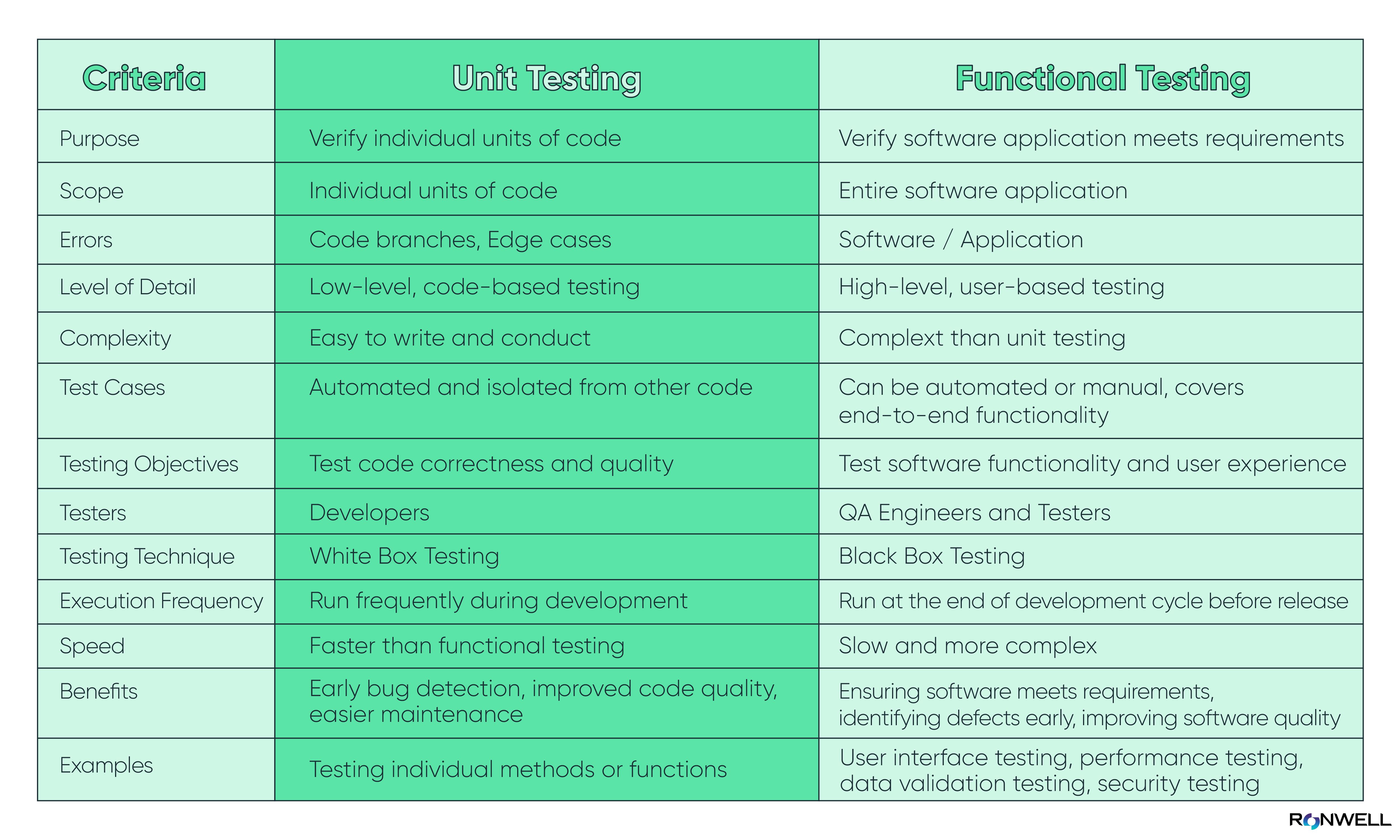

Our Services
Test Automation ServicesAI & Machine LearningBlockchainCRM ConsultingData Science & EngineeringDevOpsDigital MarketingDigital TransformationEmbedded Software DevelopmentERP Consulting ServicesManaged IT ServicesMergers & Acquisitions AdvisoryQA And Testing ServicesRobotic Process Automation SAP Consulting DevelopmentSoftware and Application DevelopmentSQL ConsultingStrategy ConsultingSustainability
- Contact Us
Our Services
- Test Automation Services
- AI & Machine Learning
- Blockchain
- CRM Consulting
- Data Science & Engineering
- DevOps
- Digital Marketing
- Digital Transformation
- Embedded Software Development
- ERP Consulting Services
- Managed IT Services
- Mergers & Acquisitions Advisory
- QA And Testing Services
- Robotic Process Automation
- SAP Consulting Development
- Software and Application Development
- SQL Consulting
- Strategy Consulting
- Sustainability
Insight
Company
Industries
- Contact Us

Unit Testing vs Functional Testing: A Detailed Comparison
Discover the key differences between Unit Test and Functional Test with comprehensive comparison table. Find out which one is right for your software needs.
- insight
- /
- blog
- /
- unit-testing-vs-functional-testing
Testing is an essential part of software development, ensuring that the code we write behaves as expected and meets our requirements. But with so many types of tests to choose from, it can be difficult to know which ones to use in different situations.
Unit and functional testing are essential software application testing components. Two popular types of tests are unit tests and functional tests, each with its own strengths and weaknesses.
In this article, we'll explore the differences between unit tests and functional tests and help you understand when and how to use each one effectively.
Whether you're a seasoned developer or starting out, this guide will help you improve your testing skills and write better, more reliable code. So let's dive in and discover the world of unit tests and functional tests!
To clarify the differences between unit tests and functional tests, let’s get started with the definition of unit testing.
If you're wondering what is automation testing!

What Is Unit Testing?
Unit testing is a type of software testing in which separate parts or units of an application are tested separately from the rest of the system. Unit testing aims to ensure that each unit of code, such as a function or method, conforms to the requirements of the program specification and operates as intended.
Unit testing involves evaluating each unit of code using automated test cases intended to exercise particular functionality and evaluate the output against anticipated outcomes.
Typically, unit tests are created by the developers themselves, and they are executed regularly throughout the development process to verify that code changes do not result in regressions.
Unit testing is an important aspect of the software development process since it ensures that each program component functions properly, enhancing the product's overall quality and dependability.
Here are some benefits of unit testing:
Unit Test Case Example
Here are some unit test case examples:
Test Case Example
Purpose: To verify that the Password Input Text box functions correctly by accepting valid passwords and rejecting invalid passwords.
Requirements:
- The password should be at least 8 characters long.
- The password should contain at least one uppercase letter, one lowercase letter, and one number.
- The password may contain special characters.
Test Procedure:
- Enter a password that meets all the requirements and verify that it is accepted.
- Enter a password that is less than 8 characters long and verify that it is rejected.
- Enter a password that does not contain an uppercase letter and verify that it is rejected.
- Enter a password that does not contain a lowercase letter and verify that it is rejected.
- Enter a password that does not contain a number and verify that it is rejected.
- Enter a password that contains special characters and verify that it is accepted.
- Enter a password that does not contain any special characters and verify that it is accepted.
- Enter a password that is exactly 8 characters long and meets all other requirements and verify that it is accepted.
- Enter a password that is longer than 8 characters but does not meet other requirements and verify that it is rejected.
Expected Results:
- The password should be accepted.
- The password should be rejected.
- The password should be rejected.
- The password should be rejected.
- The password should be rejected.
- The password should be accepted.
- The password should be accepted.
- The password should be accepted.
- The password should be rejected.
What Is Functional Testing?
Functionality testing is a type of software testing that is used to verify that a software application or system meets its functional requirements. It involves testing the application's features and functions to ensure that they are working correctly and performing as intended.
Functionality testing is typically performed manually or through automated testing tools and involves the creation of test cases that cover different scenarios and user actions. The test cases are designed to validate the expected behavior of the application's features and functions and to identify any defects or issues that may prevent the software from working as intended.
For 13 Best Load Testing Tools
Examples of functionality testing include:
- Functional integration testing: Verifying that different components of the system work together as expected.
- Performance testing: Verifying that the application performs well under normal and heavy load conditions.
- User Interface testing: Verifying the application's user-friendly, responsive, and functional interface.
- Security testing: Verifying the application is secure against unauthorized access and malicious attacks.
- Data validation testing: Verifying that the data entered into the system is correctly validated and processed.
Functionality testing is an important aspect of software testing and helps ensure that the application meets the requirements of its users and stakeholders.
Here are some benefits of functional testing:
Functional Test Case Example
Here's an example of a functional test case for logging in to an e-commerce application:
Test Case 1: Login Functionality
Step 1: Navigate to the login page of the e-commerce application.
Step 2: Enter a valid username and password combination.
Step 3: Click on the 'Submit' button.
Step 4: Verify that the user is redirected to the home page of the e-commerce application.
Step 5: Verify that the user's name is displayed on the home page.
Step 6: Verify that the user can access all the features and functionalities of the e-commerce application.
Step 7: Log out of the e-commerce application.
This functional test case verifies that the login functionality of the e-commerce application is working as expected from the user's perspective. It tests the end-to-end functionality of the application, including user interface, user experience, and business logic. It helps to identify defects in the application that may impact the user's ability to use the application effectively.
Unlike unit testing, functional testing focuses on the entire application and its interactions with external systems, ensuring that the software meets the business requirements and user expectations.
For Benefits of Outsourcing Software Testing Services
Unit Testing vs. Functional Testing
Both unit testing and functional testing are important types of software testing and serve different purposes in ensuring software quality.
Here is a comparison table between unit testing and functional testing:
| Criteria | Unit Testing | Functional Testing |
| Purpose | Verify individual units of code | Verify software application meets requirements |
| Scope | Individual units of code | Entire software application |
| Errors | Code branches, Edge cases | Software / Application |
| Level of Detail | Low-level, code-based testing | High-level, user-based testing |
| Complexity | Easy to write and conduct | Complext than unit testing |
| Test Cases | Automated and isolated from other code | Can be automated or manual, covers end-to-end functionality |
| Testing Objectives | Test code correctness and quality | Test software functionality and user experience |
| Testers | Developers | QA Engineers and Testers |
| Testing Technique | White Box Testing | Black Box Testing |
| Execution Frequency | Run frequently during development | Run at the end of development cycle before release |
| Speed | Faster than functional testing | Slow and more complex |
| Benefits | Early bug detection, improved code quality, easier maintenance | Ensuring software meets requirements, identifying defects early, improving software quality |
| Examples | Testing individual methods or functions | User interface testing, performance testing, data validation testing, security testing |
How Do They Improve Software Quality?
Both unit testing and functional testing play crucial roles in improving the overall quality of software.
Unit testing helps catch code defects early, preventing re-work and regression. It also ensures that code remains maintainable, even after months or years have passed. On the other hand, functional testing ensures that the application or system behaves as expected, with tests covering critical functionality such as user workflows and payment gateways.
Different types of functional testing, such as integration testing and system testing, provide additional benefits, such as reducing the risk of integrating new code and increasing test coverage.
Overall, incorporating both unit testing and functional testing can lead to more robust, reliable, and maintainable software.
How Do They Impact Test Coverage?
Both unit testing and functional testing impact test coverage in different ways.
Unit testing is focused on testing individual components in isolation, which can help ensure that each component of the software/application functions correctly. By covering as many individual code components as possible with unit tests, developers can achieve high code coverage and catch defects early in development.
Functional testing, on the other hand, is focused on testing the software/application as a whole from an end-user perspective. By covering all the critical functionalities of the application, functional testing can help ensure that the application meets the intended functional requirements and that it is usable for the end-users.
Together, unit testing and functional testing can provide comprehensive test coverage for the software/application. Unit testing catches defects early and ensures that individual components function correctly. In contrast, functional testing ensures that the application meets the intended functional requirements and is usable for the end users. By combining both types of testing, developers can achieve high overall test coverage and ensure high software quality.
FAQs
Is unit testing a functional test?
Unit Testing is part of Functional Testing. Functional testing is time-consuming and checks the full functioning of the software. Unit tests are efficient and tailored to individual components.
Can unit testing be used for Integration testing purposes?
Yes, unit testing can be used as a form of integration testing in certain cases. By using mock objects or stubs to simulate the behavior of dependencies, developers can test the behavior of individual components in isolation and catch integration issues early in the development cycle.
References
Zealous Web - Unit Testing vs Functional Testing
Geeks for Geeks - Difference Between Unit Tests and Functional Tests
Brightsec - Unit Testing vs Functional Testing
Browser Stack - Difference Between Unit Tests and Functional Tests
Writer:

Halime Yılmaz
Content Marketing Specialist
8 min read
9 March 2023, Thursday
Related Posts
Related Industries
Related Services














